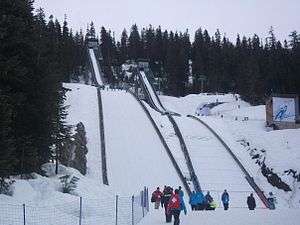Venues of the 2010 Winter Olympics
For the 2010 Winter Olympics, a total of ten sports venues were used, seven in Vancouver (including BC Place), and three in Whistler.
| Part of a series on |
| Part of a series on |


The 2010 Winter Olympic Games and Paralympic Games were held in Vancouver and Whistler, British Columbia, Canada. The Olympics ran from February 12 to February 28, 2010, and the Paralympics from March 12 to March 21, during which nine competition venues were used, spread across Vancouver, Whistler, and the neighbouring areas of West Vancouver and Richmond. The majority of ice sport events were held in Vancouver, while Whistler, which normally serves as a ski resort, hosted the snow events. Six non-competition venues, three each in Vancouver and Whistler, provided athlete housing, space for media, and locations for ceremonies associated with the Games.[1]
In its 2002 evaluation of Vancouver's bid during the bidding process for the 2010 Games, the Evaluation Commission of the International Olympic Committee (IOC) highlighted the number and quality of existing competition and training facilities as one of the bid's strengths. Of the competition venues that the bid proposed for use during the Games, six required new construction, with the remainder already built in Vancouver and Whistler. The Vancouver Organizing Committee for the Olympic Games (VANOC), which is responsible for the construction and maintenance of facilities for the Games, pledged that all new construction of permanent facilities, whether on public or private land, would be funded by the government.[2]
According to CEO John Furlong, VANOC "started our venue construction as early as possible".[3] Construction on Cypress Mountain, the first new competition venue to be completed, began in March 2006 and was completed only eight months later, three years ahead of the start of the Games.[3] By December 2007, all three competition venues at Whistler were completed and open for training and testing.[4] Final construction was completed in February 2009, and sporting events were scheduled at the venues to ensure that they would be adequately tested before hosting the Olympic events. In total, six new competition venues were constructed: Cypress Mountain, Richmond Olympic Oval, UBC Thunderbird Arena, Vancouver Olympic/Paralympic Centre, Whistler Olympic Park, and The Whistler Sliding Centre.[5]
The Whistler Sliding Centre was promoted as being one of the fastest sliding tracks in the world,[6] which caused a number of concerns about safety.[7] On February 12, 2010, hours before the opening ceremony, Georgian luger Nodar Kumaritashvili suffered a fatal crash during a training run when he was thrown off his sled and collided with a steel pole.[8] He was travelling 143.3 km/h (89.0 mph) at the time.[9] His accident came after a series of incidents in the week and reignited concerns about the track's safety.[10] Investigations were conducted the same day, concluding that the accident was not caused by deficiencies in the track. As a preventive measure, an extra 100 ft (30 m) of wall was added after the end of Turn 16, and the ice profile was changed.[11]
Competition venues


The largest competition venue was Canada Hockey Place, with a capacity of just under 19,000 spectators. For the first time, Olympic games were played on a narrower NHL-sized ice rink, measuring 61 by 26 metres (200 ft × 85 ft), instead of the international size of 61 m × 30 m (200 ft × 98 ft). This change saved an expected $10 million (CAD) in construction costs and allowed more spectators to attend games.[12] This arena, as well as the second-largest venue of Vancouver 2010, Pacific Coliseum, were pre-existing and required minimal renovation in preparation for the Olympics. Of the newly constructed venues for the Games, the Whistler Sliding Centre was the largest, with space for 12,000 spectators to observe the luge, skeleton and bobsled events. Three venues used in the Games were outside Vancouver and Whistler: Cypress Mountain in West Vancouver, the Richmond Olympic Oval in Richmond, and UBC Doug Mitchell Thunderbird Sports Centre on the University Endowment Lands.
| Venue | Location | Sports | Capacity | Ref. |
|---|---|---|---|---|
| Canada Hockey Place[lower-alpha 1] | Vancouver | Ice hockey (final) | 18,630 | [14] |
| Cypress Mountain | West Vancouver | Freestyle skiing, snowboarding | 8,000 | [15] |
| Pacific Coliseum | Vancouver | Figure skating, short track speed skating | 14,239 | [16] |
| Richmond Olympic Oval | Richmond | Speed skating | 8,000 | [17] |
| UBC Doug Mitchell Thunderbird Sports Centre | University Endowment Lands (UBC) | Ice hockey | 7,200 | [18] |
| Vancouver Olympic/Paralympic Centre | Vancouver | Curling | 6,000 | [19] |
| Whistler Creekside | Whistler | Alpine skiing | 7,600 | [20] |
| Whistler Olympic Park | Whistler | Biathlon, cross-country skiing, Nordic combined, ski jumping | 6,000 | [21] |
| Whistler Sliding Centre | Whistler | Bobsleigh, luge, skeleton | 12,000 | [22] |
Non-competition venues
Because of the significant distance between Vancouver and Whistler, Olympic Villages and media facilities were constructed in both locations. In addition, while medals ceremonies for the events held in Vancouver took place at the pre-existing BC Place, an additional venue was constructed in Whistler to award medals there. BC Place is an indoor stadium, so the Olympic torch cauldron, which was lit in the middle of the stadium during the opening ceremony, could not be left there because of safety concerns.[23] A second "external cauldron" was erected on the Coal Harbour waterfront, next to the Main Media Centre.[24]
| Venue | Location | Purpose | Ref. |
|---|---|---|---|
| BC Place | Vancouver | Opening and closing ceremonies | [25] |
| Main Media Centre | Vancouver | Media centre | [26] |
| Vancouver Olympic Village | Vancouver | Olympic Village | [27] |
| Whistler Media Centre | Whistler | Media centre | [28] |
| Whistler Olympic and Paralympic Village | Whistler | Olympic Village | [29] |
| Whistler Olympic Celebration Plaza | Whistler | Ceremonies and presentations | [30] |
See also


Notes
- Canada Hockey Place was normally known as General Motors Place at the time of the Olympics, but because corporate sponsorship is not allowed for an Olympic venue, it was renamed for the duration of the games.[13]
References
- "Venues". Vancouver Organizing Committee. Retrieved 2009-10-31.
- International Olympic Committee Evaluation Commission (2003-03-21). "Report of the IOC Evaluation Commission" (PDF). International Olympic Committee. Retrieved 2009-10-31.
- "Vancouver 2010: First Competition Venue Ready". International Olympic Committee. 2006-10-20. Retrieved 2010-10-31.
- "Vancouver 2010: Whistler Competition Venues Completed". International Olympic Committee. 2007-12-17. Retrieved 2009-10-31.
- "Vancouver 2010 Sports Venues Completed". International Olympic Committee. 2009-02-23. Retrieved 2009-10-31.
- Abrams, Jonathan (2010-02-15). "Despite Fast Track, Skeleton and Bobsled Must Stay the Course". The New York Times. Retrieved 2010-03-01.
- Cribb, Robert (2010-02-19). "Fears continue to grow". Toronto Star. Retrieved 2010-03-01.
- Abrams, Jonathan; Branch, John (2010-02-12). "Luge Athlete's Death Casts Pall Over Games". The New York Times. Retrieved 2010-03-01.
- Zinser, Lynn (2010-02-12). "Luge Athlete Killed in Training Crash at Olympics". The New York Times. Retrieved 2010-03-01.
- "Georgian luger dies after horrifying crash at Whistler track". Canwest News Service. 2010-02-12. Retrieved 12 February 2010.
- Bell, Terry (2010-02-14). "Canadian lugers unhappy over changes to track". Vancouver Sun. Archived from the original on 2010-02-19. Retrieved 2010-03-01.
- "VANOC shrinks Olympic ice". The Vancouver Sun. Canadian Online Explorer. 2009-02-24. Retrieved 2009-03-01.
- "GM Place to get new name for 2010". CTV News. 2008. Retrieved 2009-01-07.
- "Venues–Canada Hockey Place". Vancouver Organizing Committee. Retrieved 2010-03-10.
- "Venues–Cypress Mountain". Vancouver Organizing Committee. Retrieved 2010-03-10.
- "Venues–Pacific Coliseum". Vancouver Organizing Committee. Retrieved 2010-03-10.
- "Venues–Richmond Olympic Oval". Vancouver Organizing Committee. Retrieved 2010-03-10.
- "Venues–UBC Thunderbird Arena". Vancouver Organizing Committee. Retrieved 2010-03-10.
- "Venues–Vancouver Olympic/Paralympic Centre". Vancouver Organizing Committee. Retrieved 2010-03-10.
- "Venues–Whistler Creekside". Vancouver Organizing Committee. Retrieved 2010-03-10.
- "Venues–Whistler Olympic/Paralympic Park". Vancouver Organizing Committee. Retrieved 2010-03-10.
- "Venues–The Whistler Sliding Centre". Vancouver Organizing Committee. Retrieved 2010-03-10.
- Bailey, Ian; Stueck, Wendy (2010-02-15). "VANOC considering better access to outdoor cauldron". CTV Olympics. Retrieved 2010-03-15.
- Lee, Jeff (2010-02-25). "Spectacle welcomes the world to Vancouver". Vancouver Sun. Retrieved 2010-02-25.
- "Venues–BC Place". Vancouver Organizing Committee. Retrieved 2010-03-10.
- "Venues–Main Media Centre". Vancouver Organizing Committee. Retrieved 2010-03-10.
- "Venues–Olympic and Paralympic Village Vancouver". Vancouver Organizing Committee. Retrieved 2010-03-10.
- "Venues–Whistler Media Centre". Vancouver Organizing Committee. Retrieved 2010-03-10.
- "Venues–Whistler Olympic and Paralympic Village". Vancouver Organizing Committee. Retrieved 2010-03-10.
- "Venues–Whistler Medals Plaza". Vancouver Organizing Committee. Retrieved 2010-03-10.
| Wikimedia Commons has media related to Venues of the 2010 Winter Olympics. |